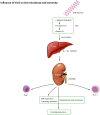Microbiome of the Skin and Gut in Atopic Dermatitis (AD): Understanding the Pathophysiology and Finding Novel Management Strategies
- PMID: 30987008
- PMCID: PMC6518061
- DOI: 10.3390/jcm8040444
Microbiome of the Skin and Gut in Atopic Dermatitis (AD): Understanding the Pathophysiology and Finding Novel Management Strategies
Abstract
Atopic dermatitis (AD) is a long-standing inflammatory skin disease that is highly prevalent worldwide. Multiple factors contribute to AD, with genetics as well as the environment affecting disease development. Although AD shows signs of skin barrier defect and immunological deviation, the mechanism underlying AD is not well understood, and AD treatment is often very difficult. There is substantial data that AD patients have a disturbed microbial composition and lack microbial diversity in their skin and gut compared to controls, which contributes to disease onset and atopic march. It is not clear whether microbial change in AD is an outcome of barrier defect or the cause of barrier dysfunction and inflammation. However, a cross-talk between commensals and the immune system is now noticed, and their alteration is believed to affect the maturation of innate and adaptive immunity during early life. The novel concept of modifying skin and gut microbiome by applying moisturizers that contain nonpathogenic biomass or probiotic supplementation during early years may be a preventive and therapeutic option in high risk groups, but currently lacks evidence. This review discusses the nature of the skin and gut flora in AD, possible mechanisms of skin-gut interaction, and the therapeutic implications of microbiome correction in AD.
Keywords: atopic dermatitis; gut; microbiome; microbiota; skin; therapeutic implications.
Conflict of interest statement
The authors declare no conflict of interest.
Figures





References
-
- Hyun D.W., Min H.J., Kim M.S., Whon T.W., Shin N.R., Kim P.S., Kim H.S., Lee J.Y., Kang W., Choi A.M.K., et al. Dysbiosis of Inferior Turbinate Microbiota Is Associated with High Total IgE Levels in Patients with Allergic Rhinitis. Infect. Immun. 2018;86 doi: 10.1128/IAI.00934-17. - DOI - PMC - PubMed
Publication types
Grants and funding
LinkOut - more resources
Full Text Sources
Other Literature Sources
Medical

